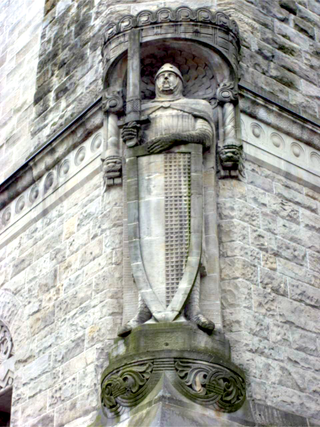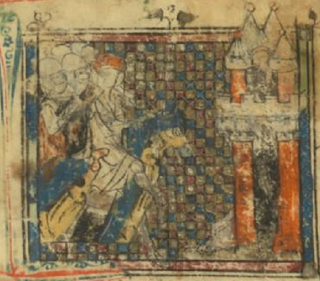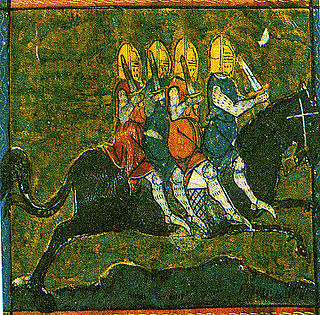
Valentine and Orson is a romance which has been attached to the Carolingian cycle.

Valentine and Orson is a romance which has been attached to the Carolingian cycle.
It is the story of twin brothers, abandoned in the woods in infancy. Valentine is brought up as a knight at the court of Pepin, while Orson grows up in a bear's den to be a wild man of the woods, until he is overcome and tamed by Valentine, whose servant and comrade he becomes. In some versions, the pair discover their true history with the help of a magical brazen head. The two eventually rescue their mother Bellisant, sister of Pepin and wife of the emperor of Greece, by whom she had been unjustly repudiated, from the power of a giant named Ferragus.
The tale is probably based on a lost French original, with Orson originally described as "sans nom" i.e. the "nameless" one. A 14th-century French chanson de geste , Valentin et Sansnom (i.e. Valentin and "Nameless") has not survived but was translated/adapted in medieval German as Valentin und Namelos (first half of the 15th century). [1]
The kernel of the story lies in Orson's upbringing and wildness, and is evidently a folk-tale, with a purely artificial connection to the Carolingian cycle. The story of the wife unjustly accused with which it is bound up is sufficiently common, and was told of the wives both of Pippin and Charlemagne. The work has a number of references to other, older, works, including: Floovant, The Four Sons of Aymon , Lion de Bourges, and Maugis d'Aigremont . [1]
Like nearly all popular romances of chivalry of the period, the French chanson de geste was adapted into a prose romance by the end of the 15th century; [2] several versions from the 16th century are extant; the oldest prose version dates from 1489 [1] (published in Lyon by Jacques Maillet). [2] An English-language version, The Historye of the two Valyannte Brethren: Valentyne and Orson, written by Henry Watson, printed by William Copland about 1550, is the earliest known of a long series of English versions - some of which included illustrations. One such illustrated variant of the tale was prepared by S R Littlwood and accompanied by the illustrations of Florence Anderson when published in 1919.
Other Renaissance versions exist in Italian, Spanish, Swedish, Dutch, [1] German, and Icelandic. The number of translations show a European success for the tale. [1] The works of François Rabelais have a number of echoes to the romance. [2]
A pageant of Valentine and "Urson" was presented in London at Cheapside during the Royal Entry before the Coronation of Edward VI in 1547. It is known that Richard Hathwaye and Anthony Munday produced a theatrical version of the story in 1598. [3] [4]
Thomas Dibdin wrote an adaptation in 1804 which was later performed at the Theatres Royal Covent Garden, Haymarket, and Bath.
Nancy Ekholm Burkert wrote and illustrated a version of the story in 1989, in which the story is told through the lens of a traveling group of players (including two brothers) who bring the story to a village in Flanders in the Middle Ages.

Roland was a Frankish military leader under Charlemagne who became one of the principal figures in the literary cycle known as the Matter of France. The historical Roland was military governor of the Breton March, responsible for defending Francia's frontier against the Bretons. His only historical attestation is in Einhard's Vita Karoli Magni, which notes he was part of the Frankish rearguard killed in retribution by the Basques in Iberia at the Battle of Roncevaux Pass.
Huon of Bordeaux is the title character of a 13th-century French epic poem with romance elements.

The chanson de geste is a medieval narrative, a type of epic poem that appears at the dawn of French literature. The earliest known poems of this genre date from the late 11th and early 12th centuries, shortly before the emergence of the lyric poetry of the troubadours and trouvères, and the earliest verse romances. They reached their highest point of acceptance in the period 1150–1250.

Renaudde Montauban was a legendary hero and knight which appeared in a 12th-century Old French chanson de geste known as The Four Sons of Aymon. The four sons of Duke Aymon are Renaud, Richard, Alard and Guiscard, and their cousin is the magician Maugris. Renaud possesses the magical horse Bayard and the sword Froberge.
The Matter of France, also known as the Carolingian cycle, is a body of literature and legendary material associated with the history of France, in particular involving Charlemagne and his associates. The cycle springs from the Old French chansons de geste, and was later adapted into a variety of art forms, including Renaissance epics and operas. Together with the Matter of Britain, which concerned King Arthur, and the Matter of Rome, comprising material derived from and inspired by classical mythology, it was one of the great European literary cycles that figured repeatedly in medieval literature.

As a literary genre, the chivalric romance is a type of prose and verse narrative that was popular in the noble courts of high medieval and early modern Europe. They were fantastic stories about marvel-filled adventures, often of a chivalric knight-errant portrayed as having heroic qualities, who goes on a quest. It developed further from the epics as time went on; in particular, "the emphasis on love and courtly manners distinguishes it from the chanson de geste and other kinds of epic, in which masculine military heroism predominates."

Medieval French literature is, for the purpose of this article, Medieval literature written in Oïl languages during the period from the eleventh century to the end of the fifteenth century.

Maugris or Maugis was one of the heroes of the chansons de geste and romances of chivalry and the Matter of France that tell of the legendary court of King Charlemagne. Maugis was cousin to Renaud de Montauban and his brothers, son of Beuves of Aygremont and brother to Vivien de Monbranc. He was brought up by Oriande the fairy, and became a great enchanter. He won the magical horse Bayard and the sword Froberge which he later gave to Renaud.

Amis et Amiles is an old French romance based on a widespread legend of friendship and sacrifice. In its earlier and simpler form it is the story of two friends, one of whom, Amis, was sick with leprosy because he had committed perjury to save his friend. A vision informed him that he could only be cured by bathing in the blood of Amiles's children. When Amiles learnt this he killed the children, who were, however, miraculously restored to life after the cure of Amis.
Macaire is a given name and surname associated with medieval France, although it appears to have several claims of origin. It was originally a male name, and later came to be considered a male or female name. Macaire is also the common name for a 12th-century French chanson de geste, named for one of its main characters.
La Geste de Garin de Monglane is the second cycle of the three great cycles of chansons de geste created in the early days of the genre. It centres on Garin de Monglane. One of its main characters is William of Gellone.

Fierabras or Ferumbras is a fictional Saracen knight appearing in several chansons de geste and other material relating to the Matter of France. He is the son of Balan, king of Spain, and is frequently shown in conflict with Roland and the Twelve Peers, especially Oliver, whose prowess he almost rivals. Fierabras eventually converts to Christianity and fights for Charlemagne.

Le Pèlerinage de Charlemagne is an Old French chanson de geste dealing with a fictional expedition by Charlemagne and his paladins. The oldest known written version was probably composed around 1140. Two 15th-century reworkings of the story are also known.
Andrea Mangiabotti, called Andrea da Barberino, was an Italian writer and cantastorie ("storyteller") of the Quattrocento Renaissance. He was born in Barberino Val d'Elsa, near Florence, and lived in Florence. He is principally known for his prose romance epic Il Guerrin Meschino, his I Reali di Francia, a prose compilation of the Matter of France epic material concerning Charlemagne and Roland (Orlandino) from various legends and chansons de geste, and for his Aspramonte, a reworking of the chanson de geste Aspremont, which also features the hero Ruggiero. Many of his writings probably derive from Franco-Italian works, such as the Geste Francor, that includes versions of the stories of Reali di Francia and dates to the first half of the fourteenth century. His works, which circulated at first in manuscript, were extremely successful and popular, and were a key source of material for later Italian romance writers, such as Luigi Pulci (Morgante), Matteo Maria Boiardo and Ludovico Ariosto.

Aymeri de Narbonne is a legendary hero of Old French chansons de geste and the Matter of France. In the legendary material, as elaborated and expanded in various medieval texts, Aymeri is a knight in the time of Charlemagne's wars with the Saracens after the Battle of Roncevaux Pass. He is son of Hernaut and the grandson of Garin de Monglane. He conquers the city of Narbonne, marries a princess named Hermengarde or Hermenjart, and fathers seven sons, the most famous being Guillaume d'Orange, the hero of several popular chansons de geste.

Prise d'Orange is a mid-12th century chanson de geste written in Old French. Its fictional story follows the hero Guillaume as he captures the walled city of Orange from Saracens and marries Orable, its queen. Other characters include Arragon, the king of Orange, and Tibaut, Orable's erstwhile husband and Arragon's father. The anonymously written poem, part of a larger cycle about Guillaume called La Geste de Garin de Monglane, consists of 1,888 decasyllable verses in laisses. It combines motifs of courtly love with an epic story of military conquest. The narrative is humorous and parodies the tropes of epic poetry.

Galiens li Restorés, or Galien le Restoré or Galien rhétoré, is an Old French chanson de geste which borrows heavily from chivalric romance. Its composition dates anywhere from the end of the twelfth century to the middle of the fourteenth century. Five versions of the tale are extant, dating from the fifteenth century to the sixteenth century, one in verse and the others in prose. The story—which is closely linked to the earlier chansons de gestePèlerinage de Charlemagne and The Song of Roland —tells of the adventures of Galien, son of the hero Olivier and of Jacqueline, the daughter of the (fictional) emperor Hugon of Constantinople.
Gormond et Isembart is an Old French chanson de geste from the second half of the eleventh or first half of the twelfth century. Along with The Song of Roland and the Chanson de Guillaume, it is one of the three chansons de geste whose composition incontestably dates from before 1150; it may be slightly younger than The Song of Roland and, according to one expert, may date from as early as 1068. The poem tells the story of a rebellious young French lord, Isembart, who allies himself with a Saracen king, Gormond, renounces his Christianity, and battles the French king. The poem is sometimes grouped with the Geste de Doon de Mayence or "rebellious vassal cycle" of chansons de geste.

The Four Sons of Aymon, sometimes also referred to as Renaud de Montauban is a medieval tale spun around the four sons of Duke Aymon: the knight Renaud de Montauban, his brothers Guichard, Allard and Richardet, their magical horse Bayard, their adventures and revolt against the emperor Charlemagne. The story had a European success and echoes of the story are still found today in certain folklore traditions.